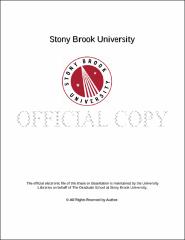| dc.identifier.uri | http://hdl.handle.net/1951/60274 | |
| dc.identifier.uri | http://hdl.handle.net/11401/71539 | |
| dc.description.sponsorship | This work is sponsored by the Stony Brook University Graduate School in compliance with the requirements for completion of degree. | en_US |
| dc.format | Monograph | |
| dc.format.medium | Electronic Resource | en_US |
| dc.language.iso | en_US | |
| dc.publisher | The Graduate School, Stony Brook University: Stony Brook, NY. | |
| dc.type | Thesis | |
| dcterms.abstract | Primates are unusual among mammals in having a well-developed hallucal grasping mechanism. Hallucal grasping has been featured in many adaptive scenarios of primate evolution. Some authors have suggested that primates possess more powerful hallucal grasping than non-primate euarchontans and that there are variations in hallucal grasping power and grasping type among primates. In these scenarios, powerful grasping is associated with the use of different substrate size and orientation and some authors have argued that these differences should be reflected in the morphology of the hallucal metatarsal (Mt1). Using data taken from the primate behavior literature, this thesis examines the morphology of the first metatarsal to establish what features are associated with differential substrate size and orientation use. This thesis further examines differences in first metatarsal morphology as it relates to grasping type and taxonomic group. The results of this study suggest that isolated features of the Mt1 are not good at distinguishing taxa with different substrate preferences or grasp type, but that taxonomic groups may be distinguished in this way. Among substrate groups, vertical clingers and leapers may be distinguishable on the basis of isolated curvatures of the proximal articular surface and peroneal process length and non-grasping taxa are significantly different from all other graspers in having lower torsion. Multivariate analyses of Mt1 shape do not successfully discriminate between substrate preference groups However, multivariate analyses of Mt1 shape across taxa that have different grasp types and belong to different taxonomic groups have high percentages of correctly classified cases. The results of this study suggest that Mt1 morphology may be useful in determining grasp type and taxonomic affinities of isolated fossil specimens, but that caution should be taken in interpreting substrate preference. | |
| dcterms.available | 2013-05-24T16:38:20Z | |
| dcterms.available | 2015-04-24T14:47:51Z | |
| dcterms.contributor | Baab, Karen L | en_US |
| dcterms.contributor | Rossie, James B | en_US |
| dcterms.contributor | Patel, Biren A | en_US |
| dcterms.contributor | Orr, Caley M. | en_US |
| dcterms.creator | Goodenberger, Katherine Elizabeth | |
| dcterms.dateAccepted | 2013-05-24T16:38:20Z | |
| dcterms.dateAccepted | 2015-04-24T14:47:51Z | |
| dcterms.dateSubmitted | 2013-05-24T16:38:20Z | |
| dcterms.dateSubmitted | 2015-04-24T14:47:51Z | |
| dcterms.description | Department of Anthropology | en_US |
| dcterms.extent | 62 pg. | en_US |
| dcterms.format | Application/PDF | en_US |
| dcterms.format | Monograph | |
| dcterms.identifier | http://hdl.handle.net/1951/60274 | |
| dcterms.identifier | http://hdl.handle.net/11401/71539 | |
| dcterms.issued | 2012-08-01 | |
| dcterms.language | en_US | |
| dcterms.provenance | Made available in DSpace on 2013-05-24T16:38:20Z (GMT). No. of bitstreams: 1
StonyBrookUniversityETDPageEmbargo_20130517082608_116839.pdf: 41286 bytes, checksum: 425a156df10bbe213bfdf4d175026e82 (MD5)
Previous issue date: 1 | en |
| dcterms.provenance | Made available in DSpace on 2015-04-24T14:47:51Z (GMT). No. of bitstreams: 3
StonyBrookUniversityETDPageEmbargo_20130517082608_116839.pdf.jpg: 1934 bytes, checksum: c116f0e1e7be19420106a88253e31f2e (MD5)
StonyBrookUniversityETDPageEmbargo_20130517082608_116839.pdf.txt: 336 bytes, checksum: 84c0f8f99f2b4ae66b3cc3ade09ad2e9 (MD5)
StonyBrookUniversityETDPageEmbargo_20130517082608_116839.pdf: 41286 bytes, checksum: 425a156df10bbe213bfdf4d175026e82 (MD5)
Previous issue date: 1 | en |
| dcterms.publisher | The Graduate School, Stony Brook University: Stony Brook, NY. | |
| dcterms.subject | Grasping, Hallux, Locomotion, Primate | |
| dcterms.subject | Physical anthropology | |
| dcterms.title | Morphological Correlates of Primate Hallucal Grasping | |
| dcterms.type | Thesis | |

